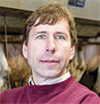There is increased pressure from consumers for dairy farmers to minimize their impact on global warming by reducing energy consumption. Even though energy use is not a large portion of the total production costs on a dairy, it only makes economic sense to make the most efficient use of energy on the farm.
Energy use in the barn
Given the differences in size, construction, components (i.e., milking cooling system, lighting) and management of dairy barns, there is a large range in energy use between barns and farms. Table 1 shows the breakdown of electricity use within farms by two different auditing firms for system components.

The majority of electricity is used in the milk harvesting and cooling process, ventilation and lighting. Energy use on dairy farms in Ontario varied from 571 to 1946 kilowatt-hours (kWh) per cow per year. On average, energy use was higher in tiestall barns than freestall barns (1417 versus 837 kWh per cow per year). Grazing and open lot dairies use less electricity than confinement dairies.
The wide range in estimated energy use per cow and by system component highlights the opportunity on many farms to reduce energy use. There are many opportunities to make more efficient use of energy for one or more of the system components. However, the first step is understanding energy use and efficiency for your type of operation.
Where do I start?
Figure 1 shows an energy pyramid developed by the major U.S. energy-auditing firm EnSave. The figure presents a logical progression in how to develop an energy saving plan.

Let’s focus on the three steps that make up the base of the pyramid:
Step 1: Energy analysis
An energy analysis, or energy audit, identifies the areas and magnitude of energy use on the farm and in the dairy operation. Most audit programs include suggestions for equipment and management practices to improve energy efficiency and then estimate the cost savings associated with the change.
Some of the questions that may be asked during the audit include: Does the equipment have a regular maintenance schedule? Is the equipment in good working order? Is equipment being run even when not in use? There is a cost, but there are sometimes cost-share opportunities, for these energy audits.
Step 2: Energy conservation
The second step on the pyramid is energy conservation. Some suggestions might include installing automatic timers on lights and correctly staging ventilating and circulating fans to optimize animal welfare and save energy.
Step 3: Energy pyramid
Energy efficiency is the third step on the energy pyramid. Regular equipment maintenance can have a major impact on how efficiently energy is being used. Upgrading to more energy-efficient equipment requires an initial investment, but may be less costly in the long run because of energy savings. PD
James Salfer and Kevin Janni are from University of Minnesota. Erin Cortus is from South Dakota State University.
References omitted but are available upon request. Click here to email an editor.











